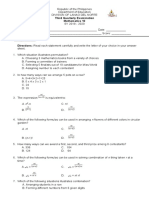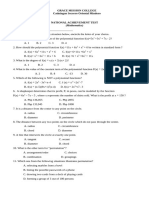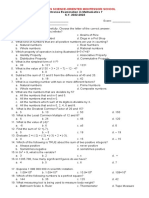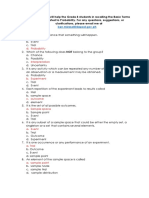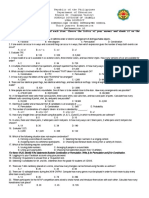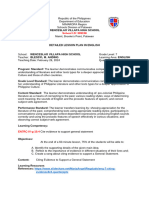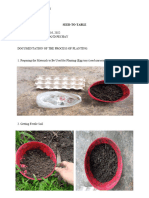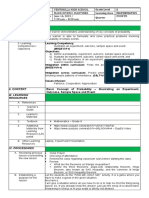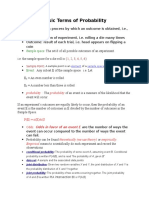0 ratings0% found this document useful (0 votes)
17 viewssummative test Q3
summative test Q3
Uploaded by
JENY VEV GAYOMAENGFLISH FILE
Copyright:
© All Rights Reserved
Available Formats
Download as DOCX, PDF, TXT or read online from Scribd
summative test Q3
summative test Q3
Uploaded by
JENY VEV GAYOMA0 ratings0% found this document useful (0 votes)
17 views6 pagesENGFLISH FILE
Copyright
© © All Rights Reserved
Available Formats
DOCX, PDF, TXT or read online from Scribd
Share this document
Did you find this document useful?
Is this content inappropriate?
ENGFLISH FILE
Copyright:
© All Rights Reserved
Available Formats
Download as DOCX, PDF, TXT or read online from Scribd
Download as docx, pdf, or txt
0 ratings0% found this document useful (0 votes)
17 views6 pagessummative test Q3
summative test Q3
Uploaded by
JENY VEV GAYOMAENGFLISH FILE
Copyright:
© All Rights Reserved
Available Formats
Download as DOCX, PDF, TXT or read online from Scribd
Download as docx, pdf, or txt
You are on page 1of 6
WENCESLAO VILLAPA HIGH SCHOOL
Mainit, Brooke’s Point, Palawan
Third Quarter Assessment in Math 10
Name: __________________________LRN:_________________________ Section:___________ Score:______
Direction: Read and analyze each item. Write the letter of the correct answer on the blank space provided before
each number.
1. What do you call to the arrangements of a set of objects in a particular order?
a. Combination
b. Permutation
c. Circular
d. Distinguishable
2. What do you call to the arrangement of objects in a circular manner?
a. Combination
b. Permutation
c. Circular
d. Distinguishable
3. How many ways can we arrange the letters in the word COMMITTEE?
a. 45, 360 ways
b. 45, 000 ways
c. 36, 450 ways
d. 36, 000 ways
4. What do you call to the arrangement of objects with identical?
a. Combination
b. Permutation
c. Circular
d. Distinguishable
5. What is the value of P(6, 0)?
a. 6
b. 5
c. 4
d. 1
6. What is the value of P(5,1)?
a. 6
b. 5
c. 4
d. 1
7. How many ways can 8 people be seated at a round table?
a. 5, 040
b. 720
c. 120
d. 24
8. What is the formula of circular permutation?
a. P = (n-1)!
n!
b. P=
n−1
n!
c. P=
1
d. P = (n-1)
9. In how many ways can we arrange number 911?
a. 4
b. 3
c. 2
d. 1
10. Which situation illustrates permutation?
a. forming a committee of councilors
b. assigning rooms to conference participants
c. choosing 2 literature books to buy from a variety of choices
d. selecting 10 questions to answer out of 15 questions in a test
11. The following are the examples of combination EXCEPT.
a. A committee of 5 person will be chosen from a group of 7 persons.
b. A principal choose 10 of their 30 teachers to attend a conference abroad.
c. Five students are chosen from class of 35 for a field trip.
d. Determining the top three winners in a science quiz bee.
12. What do you call to the arrangement of objects with no repetitions and order is NOT important?
a. Combination
b. Permutation
c. Probability
d. Events
13. Calculate 7C5.
a. 20
b. 21
c. 22
d. 23
14. Which of the following situations illustrates combination?
a. Opening a combination lock of a luggage.
b. A classroom sitting arrangement.
c. Choosing 5 questions to answer out of 10 questions in a test.
d. None of the above
15. How many ways can a coach choose three swimmer from among five swimmers?
a. 10
b. 20
c. 30
d. 40
16. Which among the following is the formula of combination?
n!
a.
( n−r ) ! r !
b. ( n−1 ) !
n!
c.
( n−1 ) !
n!
d.
n 1! n 2 ! n 3 ! … nk !
17. Which of the following situations illustrates combination?
a. arranging books in a shelf
b. forming plate numbers of vehicles
c. forming different numbers from 5 given digits
d. drawing names from a box containing 200 names
18. In a round table, how many ways can 9 different colored chairs be arranged?
a. 40, 320
b. 5, 040
c. 720
d. 60
19. Which of the following illustrate circular permutation?
a. Five persons are seated in a row.
b. Five different plates are arranged at a round table
c. Five persons stood in a line
d. None of the above.
20. Calculate P(6, 4).
a. 30
b. 120
c. 360
d. 720
21. What do you call to the set of all possible outcomes?
a. Probability
b. Experiment
c. Simple event
d. Sample space
22. What are the possible outcomes of rolling a die?
a. S = {1, 2, 3, 4, 5, 6}
b. S = {2, 4, 6}
c. S = {2, 3, 5}
d. S = {1, 2, 3, 4, 5}
23. What do you call to the event that have a single outcome?
a. Sample space
b. Simple event
c. Mutually
d. Not-mutually
24. What is the probability of getting a head in tossing a coin?
1
a.
2
1
b.
6
1
c.
3
1
d.
4
25. In rolling a die, what is the probability of getting 4?
1
a.
2
1
b.
6
1
c.
3
1
d.
4
26. What is the probability of getting a month that begins with J?
1
a.
2
1
b.
6
1
c.
3
1
d.
4
27. What are the possible outcomes of tossing two coins?
a. S = {H, T}
b. S = {HH, HT, TH, TT}
c. S = {H, T, H}
d. S = {HH, TT}
28. What is the probability of drawing a diamond or a face card in a deck of 52 cards?
5
a.
26
7
b.
26
9
c.
26
11
d.
26
29. What is the probability of getting 5 or 2 in rolling a die?
1
a.
3
7
b.
6
2
c.
6
1
d.
2
30. Below are valid probability values, EXCEPT:
a. 0
b. 0.6
11
c.
15
5
d.
3
31. What statement does the shaded region of the figure on the right represent?
a. A or B
b. A and B
c. Not A
d. Not B
32. A fair die is rolled. Let A = {even numbers} and B = {number greater than 2}. What is A ∩ B?
a. A ∩ B= { 4 , 6 }
b. A ∩ B= { 4 , 5 , 6 }
c. A ∩ B= {2 , 3 , 4 , 5 , 6 }
d. A ∩ B= {2 , 4 ,6 }
33. What is the definition of the union of two mathematical sets, A and B?
a. The set of elements that are in either set A or set B.
b. The set of elements that are in set A, but not in set B.
c. The set of elements that are in set B, but not in set A.
d. The set of all elements that are both in set A and in set B.
34. What do you call to the set of all elements that are common in both set A and set B?
a. Union
b. Intersection
c. Complement
d. Simple event
35. A bag of tiles contains the letters of the word INTEGER. What is the probability of picking the letter N or
E?
2
a.
7
3
b.
7
1
c.
3
2
d.
3
36. Which of the following formulas represent the probability of mutually exclusive events?
a. P ( A∨B ) =P ( A ∪ B )=P ( A )+ P ( B )
b. P ( A∨B ) =P ( A ∪ B )=P ( A )−P ( B ) + P( A∧B)
c. P ( A∨B ) =P ( A ∪ B )=P ( A )+ P ( B )−P ( A∧B )
d. P(A or B) = P(A) – P(B)
37. What do you call to the occurrence of one event not affecting the probability of another event?
a. dependent
b. compound
c. independent
d. simple
38. Which of the following events is mutually exclusive?
a. Getting a grade of 90 in Math and grade of 90 in English.
b. Rolling a pair die and getting even number or a multiple of 6.
c. Rolling a die and getting a number 2 and 4.
d. Watching movie and eating popcorn.
39. What is the probability of getting 8 in rolling a die?
1
a.
2
1
b.
6
c. 0
d. 1
40. What do you call to the occurrence of one event affects the probability of another event?
a. Dependent
b. Independent
c. Compound
d. Simple
You might also like
- Grade 10 Math Exam 3rd FINALDocument4 pagesGrade 10 Math Exam 3rd FINALBill Villon80% (10)
- ATI TEAS Calculation Workbook: 300 Questions to Prepare for the TEAS (2024 Edition)From EverandATI TEAS Calculation Workbook: 300 Questions to Prepare for the TEAS (2024 Edition)No ratings yet
- Probability PPT 2Document32 pagesProbability PPT 2BejiNo ratings yet
- Grade 10 Math Exam 3rd FINAL PDFDocument3 pagesGrade 10 Math Exam 3rd FINAL PDFBill Villon100% (1)
- Third Quarterly Examination Mathematics 10: N R N RDocument7 pagesThird Quarterly Examination Mathematics 10: N R N RHanifah Edres Daluma50% (2)
- Schools Division Office of Camarines Sur Learning Activity Sheet No. 2Document4 pagesSchools Division Office of Camarines Sur Learning Activity Sheet No. 2Mary graceNo ratings yet
- Accel Math 6/7 - Probability Study GuideDocument13 pagesAccel Math 6/7 - Probability Study Guideaku anggunNo ratings yet
- Math 10 Q3 BDocument4 pagesMath 10 Q3 BCHRISTEL JANE SUELLONo ratings yet
- 3RD PTMath 10 20-19-2020Document4 pages3RD PTMath 10 20-19-2020Delia Gapusan100% (4)
- Math 10 Q3 ReviewerDocument4 pagesMath 10 Q3 ReviewerCHRISTEL JANE SUELLONo ratings yet
- Math 10 3Q Exam ADocument4 pagesMath 10 3Q Exam ACHRISTEL JANE SUELLONo ratings yet
- First Fruit g6'Document4 pagesFirst Fruit g6'ekae2095No ratings yet
- Nat Math ReviewerDocument5 pagesNat Math ReviewerMaria Angelica DeniaNo ratings yet
- Suumative TestDocument2 pagesSuumative TestBaby Ann MotarNo ratings yet
- 3rd Quarter Assessment Math 10Document5 pages3rd Quarter Assessment Math 10Erick DiosoNo ratings yet
- 3rd Quarter Periodical ReviewerDocument60 pages3rd Quarter Periodical ReviewerBea GarbilesNo ratings yet
- NGEC 4 Final ExamDocument3 pagesNGEC 4 Final ExamJustiniano SalicioNo ratings yet
- Third Quarter Examination in Mathematics 10Document3 pagesThird Quarter Examination in Mathematics 10donna grace supnadNo ratings yet
- 3rd PTDocument3 pages3rd PTKimberley TadeoNo ratings yet
- Diagnostic Test Math 7Document3 pagesDiagnostic Test Math 7Danica CapinaNo ratings yet
- Summative TestDocument7 pagesSummative TestJhunlarry /100% (1)
- 3Q Math 10 TQDocument3 pages3Q Math 10 TQLyca Mia CuananNo ratings yet
- Final Exam 10Document2 pagesFinal Exam 10chenna.saulong16No ratings yet
- Math 10Document3 pagesMath 10Romeo Jr Pacheco Opena100% (1)
- Third Periodical Test in Mathematics Grade 10Document4 pagesThird Periodical Test in Mathematics Grade 10Emelyn V. CudapasNo ratings yet
- 3RDPT 2023Document4 pages3RDPT 2023Myra Ramirez RamosNo ratings yet
- Computer Entrance PreviousDocument7 pagesComputer Entrance Previousarjunkj500No ratings yet
- RRB CBT - 6Document10 pagesRRB CBT - 6Judsen ChristopherNo ratings yet
- 3rd Periodical - FINALDocument15 pages3rd Periodical - FINALMara Ciela CajalneNo ratings yet
- 3RD Quarter Examination in Math 10Document4 pages3RD Quarter Examination in Math 10Enrico EusebioNo ratings yet
- Math 6 - Q2 - PT - NewDocument4 pagesMath 6 - Q2 - PT - NewBagawang ES (R V - Catanduanes)100% (1)
- General Math Part OneDocument101 pagesGeneral Math Part OneGian Carlo GatusNo ratings yet
- 4th Grading Pre Final Test For Grade 10Document4 pages4th Grading Pre Final Test For Grade 10Princess ShirahoshiNo ratings yet
- Q2 Math 6Document5 pagesQ2 Math 6marygrace.gabuyaNo ratings yet
- 4th PTDocument3 pages4th PTFaye LouraneNo ratings yet
- Pre Test Math5Document8 pagesPre Test Math5MARCELINA G. SACULONo ratings yet
- Grade 8 Fourth Quarter Exam1Document5 pagesGrade 8 Fourth Quarter Exam1FernandoGavinCautonNo ratings yet
- Math 10 DiagnosticDocument2 pagesMath 10 DiagnosticFloraville Lamoste-MerencilloNo ratings yet
- Diagnostic Test MATH 4Document3 pagesDiagnostic Test MATH 4Neriza JeanNo ratings yet
- Math 10 Quarter 3Document3 pagesMath 10 Quarter 3Rustom Torio QuilloyNo ratings yet
- Math Exams. 1 To 6Document22 pagesMath Exams. 1 To 6FranzDimaapiNo ratings yet
- Lets22 Ultimate Math FinalDocument30 pagesLets22 Ultimate Math FinalJudie Jane MuegaNo ratings yet
- Periodic Test in Math 7Document3 pagesPeriodic Test in Math 7Mon DilligNo ratings yet
- Summative Test Grade 10Document6 pagesSummative Test Grade 10John Loyd AsaytunoNo ratings yet
- Review in Enhanced Mathematics 10 1Document21 pagesReview in Enhanced Mathematics 10 1Jana Mae Catot Acabal0% (1)
- Third Quarter Examination: Mathematics 10 (SY: 2022 - 2023)Document4 pagesThird Quarter Examination: Mathematics 10 (SY: 2022 - 2023)JAMES CRUZNo ratings yet
- Grade 10 Exam MathDocument6 pagesGrade 10 Exam MathVinson AlejandroNo ratings yet
- Day 3Document10 pagesDay 3ize_angel14No ratings yet
- Math 10 - Division Summative Test 2023Document7 pagesMath 10 - Division Summative Test 2023cherish calachanNo ratings yet
- M1 ExercisesDocument7 pagesM1 Exerciseslangleyfalls765No ratings yet
- 3rd QUARTER EXAMINATIONDocument4 pages3rd QUARTER EXAMINATIONIrish Thea AlegadoNo ratings yet
- Department of Education: Republic of The PhilippinesDocument6 pagesDepartment of Education: Republic of The Philippinesadith.mangaronNo ratings yet
- MATH QUIZ BEE FINAL ROUND G.3-6Document8 pagesMATH QUIZ BEE FINAL ROUND G.3-6mariamagallanes633No ratings yet
- Basic Probability Reviewer PDFDocument7 pagesBasic Probability Reviewer PDFMoody HaniiNo ratings yet
- Basic Probability ReviewerDocument7 pagesBasic Probability Reviewerjaniah mahinayNo ratings yet
- Primary 4 Exam NewDocument4 pagesPrimary 4 Exam Newitse okoroNo ratings yet
- 1st Periodical TestDocument3 pages1st Periodical TestJR100% (3)
- Math5 Diagnostic TestDocument8 pagesMath5 Diagnostic TestMONICA SANTOSNo ratings yet
- Periodical Test For Grade 10Document2 pagesPeriodical Test For Grade 10jezreel arancesNo ratings yet
- Math 6 - Q2 - PT - NewDocument5 pagesMath 6 - Q2 - PT - NewRey EnsepedoNo ratings yet
- Math 10Document4 pagesMath 10Sheila Mae Fabavier-MailemNo ratings yet
- Grade 4 Worksheet 3 Semester 1Document7 pagesGrade 4 Worksheet 3 Semester 1rooky1993tNo ratings yet
- TOS for English- 3rd QuarterDocument10 pagesTOS for English- 3rd QuarterJENY VEV GAYOMANo ratings yet
- GRADE 7- 3rd Quarter Exam Final na talagaDocument4 pagesGRADE 7- 3rd Quarter Exam Final na talagaJENY VEV GAYOMANo ratings yet
- Lesson Plan For Grade 7 - Q-3 Module 5Document10 pagesLesson Plan For Grade 7 - Q-3 Module 5JENY VEV GAYOMANo ratings yet
- class program 2024-2025 FINALDocument15 pagesclass program 2024-2025 FINALJENY VEV GAYOMANo ratings yet
- DLL_GROUP-5Document9 pagesDLL_GROUP-5JENY VEV GAYOMANo ratings yet
- GRADE 7-4th Quarter ExaminationDocument4 pagesGRADE 7-4th Quarter ExaminationJENY VEV GAYOMANo ratings yet
- Seed To TableDocument2 pagesSeed To TableJENY VEV GAYOMANo ratings yet
- Answer Key for 4th QuarterDocument4 pagesAnswer Key for 4th QuarterJENY VEV GAYOMANo ratings yet
- Spinning WheelDocument1 pageSpinning WheelJENY VEV GAYOMANo ratings yet
- GRADE 7- 3rd Quarter Exam Final na talaga - ANSWER KEYDocument3 pagesGRADE 7- 3rd Quarter Exam Final na talaga - ANSWER KEYJENY VEV GAYOMANo ratings yet
- Q2 Exam in MapehDocument3 pagesQ2 Exam in MapehJENY VEV GAYOMANo ratings yet
- Lesson Plan For Grade 7 Q-3 Module 6 - Elements of Narrative TextDocument10 pagesLesson Plan For Grade 7 Q-3 Module 6 - Elements of Narrative TextJENY VEV GAYOMANo ratings yet
- Interpreting and Organizing The Periodic Table Worksheet With Answer KeyDocument2 pagesInterpreting and Organizing The Periodic Table Worksheet With Answer KeyJENY VEV GAYOMANo ratings yet
- TOS for English- 4th QuarterDocument9 pagesTOS for English- 4th QuarterJENY VEV GAYOMANo ratings yet
- Table of Specification For Quarter Iv Assessment SY: 2021 - 2022Document5 pagesTable of Specification For Quarter Iv Assessment SY: 2021 - 2022JENY VEV GAYOMANo ratings yet
- Fitness ProtocolDocument4 pagesFitness ProtocolJENY VEV GAYOMANo ratings yet
- Module 3 QuizDocument1 pageModule 3 QuizJENY VEV GAYOMANo ratings yet
- Grade 8Document3 pagesGrade 8JENY VEV GAYOMANo ratings yet
- Presentation 1Document17 pagesPresentation 1JENY VEV GAYOMANo ratings yet
- Science 10 2nd Quarter Wk1Document10 pagesScience 10 2nd Quarter Wk1JENY VEV GAYOMANo ratings yet
- Teaching-Guide-Catchup-Template-Health-Grade7-science 8 LiteracyDocument3 pagesTeaching-Guide-Catchup-Template-Health-Grade7-science 8 LiteracyJENY VEV GAYOMANo ratings yet
- Grade 10 SciDocument3 pagesGrade 10 SciJENY VEV GAYOMANo ratings yet
- Science 10Document3 pagesScience 10JENY VEV GAYOMANo ratings yet
- Q4 Mapeh 9 ExamDocument4 pagesQ4 Mapeh 9 ExamJENY VEV GAYOMANo ratings yet
- 4TH Science 10 ExamDocument3 pages4TH Science 10 ExamJENY VEV GAYOMANo ratings yet
- Lesson Plan Science 10Document8 pagesLesson Plan Science 10JENY VEV GAYOMANo ratings yet
- 4TH Periodical Exam Science 8Document3 pages4TH Periodical Exam Science 8JENY VEV GAYOMANo ratings yet
- Lecture 5Document31 pagesLecture 5Ela Man ĤămměŕşNo ratings yet
- G8DLL Q4W6Document5 pagesG8DLL Q4W6Mark Kiven MartinezNo ratings yet
- RVSPDocument47 pagesRVSPSasi BhushanNo ratings yet
- Chapter 1 Basic Concepts of Statistics and Probability - RevisitedDocument6 pagesChapter 1 Basic Concepts of Statistics and Probability - RevisitedGerlie AmparadoNo ratings yet
- StatDocument15 pagesStatJohn Paul CabandonNo ratings yet
- Unit IVDocument28 pagesUnit IVabcdNo ratings yet
- Introduction To ProbabilityDocument12 pagesIntroduction To ProbabilityAriel Raye RicaNo ratings yet
- Probability GCSEDocument49 pagesProbability GCSEDheeraj YadavNo ratings yet
- Lesson Plan 128Document4 pagesLesson Plan 128Jay AqnamagisaNo ratings yet
- STAT272 Topic2 2015Document40 pagesSTAT272 Topic2 2015Jason D ChenNo ratings yet
- Oswaal_maths_2_6Document16 pagesOswaal_maths_2_6yozalee054No ratings yet
- Lec 2Document98 pagesLec 2Malika NurpeisovaNo ratings yet
- Topic One - Probability TheoryDocument20 pagesTopic One - Probability TheorykabugasalamaNo ratings yet
- Sta 101 Group D Lecture NoteDocument26 pagesSta 101 Group D Lecture NoteAbdulsamad OyetunjiNo ratings yet
- Basic Terms of ProbabilityDocument7 pagesBasic Terms of ProbabilityAbdul HafeezNo ratings yet
- Chapter 1 - Part 2 PDFDocument18 pagesChapter 1 - Part 2 PDFأحمد الرقبNo ratings yet
- (Timothy Childers) Philosophy and ProbabilityDocument213 pages(Timothy Childers) Philosophy and ProbabilityHelvert BarrabasNo ratings yet
- Xi Maths See 2020-21 Kv1afs PuneDocument6 pagesXi Maths See 2020-21 Kv1afs PuneSimranNo ratings yet
- 1.017/1.010 Class 3 Probability: Conceptual FrameworkDocument3 pages1.017/1.010 Class 3 Probability: Conceptual FrameworkDr. Ir. R. Didin Kusdian, MT.No ratings yet
- Stat 230 NotesDocument248 pagesStat 230 NotesThomas JosephNo ratings yet
- Sheet 2: Sample SpaceDocument8 pagesSheet 2: Sample SpaceYousef Abu-ElkhearNo ratings yet
- ProbabilityDocument35 pagesProbabilityShakil Safin OrthoNo ratings yet
- ProbabilityDocument38 pagesProbabilityHạnh Nguyễn ThịNo ratings yet
- Basic Concepts of Probability - DemoDocument5 pagesBasic Concepts of Probability - DemoVanessa G. ManguilimotanNo ratings yet
- PROBABILITYDocument14 pagesPROBABILITYoxyde blogyNo ratings yet
- Fundamental Principles of CountingDocument16 pagesFundamental Principles of Countingmichael noveroNo ratings yet
- Chapter3 StatsDocument6 pagesChapter3 StatsPoonam NaiduNo ratings yet




